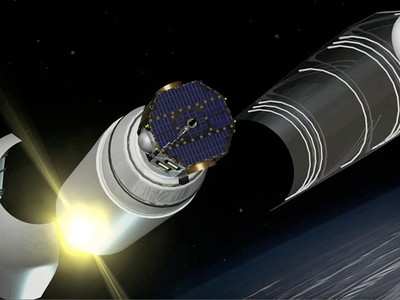Fri, Nov 14, 2008
SwRI-Led Team Begins Instrument Commissioning
Just over three weeks since
its October 19 launch, NASA's Interstellar
Boundary Explorer (IBEX) spacecraft -- the first mission designed
to image the interaction at the edge of the solar system --
concluded its orbit-raising phase and is beginning instrument
commissioning in preparation to start science observations.

After its launch to low Earth orbit (about 140 miles) onboard a
Pegasus rocket, the spacecraft used its own solid rocket motor and
hydrazine propulsion system to perform a series of burns that
ultimately raised its apogee (furthest point from Earth) to about
200,000 miles and its perigee (closest point) to about 8,000 miles
above the Earth — an orbit ideal for its science mission.
"Because the orbit goes so far out -- about five-sixths of the
way to the Moon -- it gets pushed around significantly by lunar
gravity and evolves over time in altitude and inclination," said
IBEX Principal Investigator Dr. David McComas, senior executive
director of the Space Science and Engineering Division at Southwest
Research Institute. "We're now in an orbit that provides excellent
science viewing and no long eclipses for at least the next two to
three years, without the need for additional burn maneuvers."
Before the science investigation begins, the IBEX team will
commission those spacecraft subsystems that weren't needed for the
orbit-raising period as well as the two IBEX science instruments.
During commissioning, the spacecraft spin rate will be reduced from
23 rpm to 4 rpm and pointed toward the Sun. At that point, the
remaining subsystems and instruments will be turned on and tuned to
ensure optimum mission performance.
When it begins its science observations in early December, IBEX
will use energetic neutral atom imaging to create the first-ever
all-sky maps of the interactions between the million mile-per-hour
solar wind blown out by the Sun and the low-density material
between the stars, known as the interstellar medium. The spacecraft
will complete an all-sky map of the interstellar boundaries every
six months.
IBEX is the latest in NASA's series of low-cost, rapidly
developed Small Explorers spacecraft. SwRI leads the IBEX mission
that includes a team of national and international partners. The
NASA Goddard Space Flight Center manages the Explorers Program for
the Science Mission Directorate in Washington.
More News
Airport Marking Aids Markings used on runway and taxiway surfaces to identify a specific runway, a runway threshold, a centerline, a hold line, etc. A runway should be marked in ac>[...]
"It is extremely difficult, if not impossible, for manned aircraft to see a drone while conducting crop-enhancing and other aerial applications at low altitudes and high speeds. We>[...]
Aero Linx: The Skyhawk Association The Skyhawk Association is a non-profit organization founded by former Skyhawk Pilots which is open to anyone with an affinity for the A-4 Skyhaw>[...]
“The T-54A benefits from an active Beechcraft King Air assembly line in Wichita, Kansas, where all required METS avionics and interior modifications are installed on the line>[...]
Aero Linx: Aerostar Owners Association The Association offers the Aerostar Owner a unique opportunity to tap an invaluable source of information concerning the care and feeding of >[...]
 ANN's Daily Aero-Term (04.28.24): Airport Marking Aids
ANN's Daily Aero-Term (04.28.24): Airport Marking Aids Aero-News: Quote of the Day (04.28.24)
Aero-News: Quote of the Day (04.28.24) ANN's Daily Aero-Linx (04.28.24)
ANN's Daily Aero-Linx (04.28.24) Aero-News: Quote of the Day (04.29.24)
Aero-News: Quote of the Day (04.29.24) ANN's Daily Aero-Linx (04.29.24)
ANN's Daily Aero-Linx (04.29.24)



